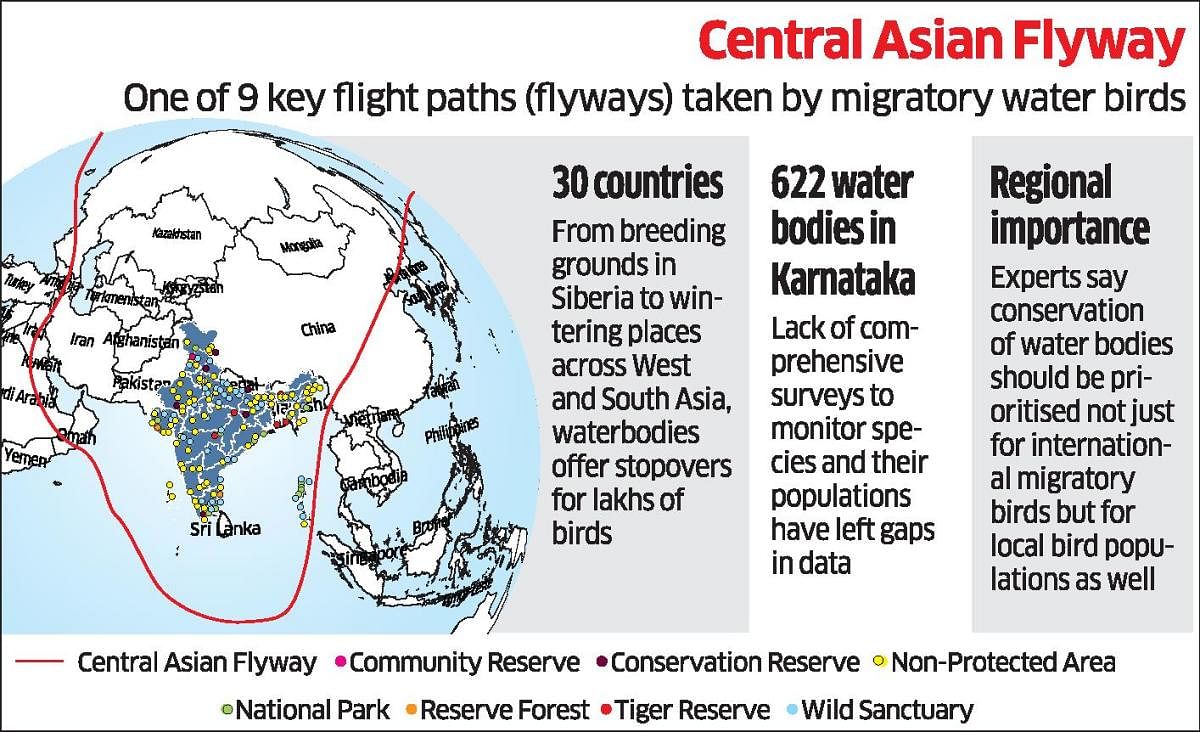

The draft national action plan (NAP) to protect wetlands in the country that plays host to birds from far off regions of Eurasia and Siberia does not include a single site from the 622 water bodies in Karnataka, thanks to the decades of ignorance by officials. This lack of attention has also led to encroachment and destruction of such water bodies.
The water birds use the wetlands in the flyway region for a breeding, stop-over and resting (wintering) purposes. In the draft NAP, the Union Ministry of Environment, Forests and Climate Change notes that wetlands in India provide stopover sites for 90% of the bird species.
The Ministry has identified 20 major wetlands and nine wetland clusters across the country. This includes eight sites from Maharashtra, nine from Tamil Nadu, three each from Andhra Pradesh and Puducherry and five from Rajasthan. Curiously, none of the major wetlands from state figure in the draft.
As per a study by Sálim Ali Centre for Ornithology and Natural History, Karnataka has 622 wetlands that are bigger than 52.25 hectares of which 21 were qualified to be assigned as ‘Ramsar sites’, which provides access to financial and policy-related support through the international convention.
Experts and enthusiasts alike said the absence of sites from Karnataka was a cause for concern. “It shows how less we have cared for birds over the last few decades. It is not that surveys are not done. Several enthusiasts, including those in official circles, have spent years to compile data. But the lack of a policy-level measure to come up with comprehensive statistics in a state like Karnataka is worrying,” he said.
Chief Wildlife Warden C Jayaram acknowledged that the draft does not include sites in Karnataka due to lack of documentation. “We have already taken up a census and Dr S Subramanya is heading it. Once we get figures, we will propose to the Centre to notify the sites as conservation sites of migratory birds,” he said.
Jayaram said it was the late Salim Ali who had the idea of documenting the birds in the state in a comprehensive study. “After that, there was no initiative till recently,” he said.
Noting that some of the sanctuaries in Karnataka are known for in-situ birds and not migratory ones, he said the latest survey would help in throwing light on biodiversity in some of the water bodies.
Ornithologist Krishna M B said international criteria, especially for migratory waterbirds, tend to look at species’ populations at a global level. Being a species-rich tropical country, we need to look at waterbird diversity too and need to prioritise sites at the regional level. “For many species, our sites may not hold populations large enough for international interest. But it does not mean they are not important in a regional context. Our efforts should go beyond mere species listing for sites and encompass populations too,” he said.
He said there are fundamental issues which have to be sorted out before jumping on the bandwagon of international criteria.
“We need to develop national and state-level criteria for better classification and conservation of wetlands. Blindly following international standards will be at the peril of regional biodiversity,” he cautioned.
Sridhar S, former regional director of Asian Wetland Bureau, said there were 38 tanks proposed for a regular watch. “Bellandur lake, Hoskote tank and Byramangala reservoir received tens of thousands of birds. Much of it has been forgotten now,” he said.